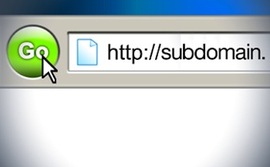 User-generated article site HubPages was one of the thousands of websites hit hardest by Google’s Panda update. But now they claim to have a solution that works: dividing its website into thousands of subdomains. But is this a legit workaround?
User-generated article site HubPages was one of the thousands of websites hit hardest by Google’s Panda update. But now they claim to have a solution that works: dividing its website into thousands of subdomains. But is this a legit workaround?
Now, before we get into this advice and you learn that HubPages’ CEO Paul Edmondson was contacted directly by Google’s Matt Cutts last month (amazing what access you get when you rake in $10 million in AdSense per year, isn’t it?), know that there is much skepticism by SEOs around the long-term viability of this strategy.
Here’s what the Wall Street Journal reported yesterday:
In June, a top Google search engineer, Matt Cutts, wrote to Edmondson that he might want to try subdomains, among other things. The HubPages subdomain testing began in late June and already has shown positive results. Edmondson’s own articles on HubPages, which saw a 50% drop in page views after Google’s Panda updates, have returned to pre-Panda levels in the first three weeks since he activated subdomains for himself and several other authors. The other authors saw significant, if not full, recoveries of Web traffic.
The goal, as HubPages saw it, was to separate excellent authors from weak authors, and allow Google to determine “high quality” from “low quality,” which is what Google has been saying is the ultimate goal of Panda and its other algorithmic tweaks. HubPages announced it is using the new rel=author meta tag, so they are separating based on author, not topic, and are using 301 redirects from the original page to the new author subdomain.
The WSJ also pointed to a post by Cutts discussing subdomains and subdirectories. Of note:
A subdomain can be useful to separate out content that is completely different. Google uses subdomains for distinct products such news.google.com or maps.google.com, for example. If you’re a newer webmaster or SEO, I’d recommend using subdirectories until you start to feel pretty confident with the architecture of your site. At that point, you’ll be better equipped to make the right decision for your own site.
Also worth noting is that shortly after Panda was released, Google’s Michael Wyszomierski said that “Removing low quality pages or moving them to a different domain could help your rankings for the higher quality content.”
There are few Google Panda recovery tales – we previously reported on the efforts of two websites, but honestly neither claimed much better than stabilization after losing at least 50 percent of traffic – so it’s probably tempting to rush out and implement this, right?
Veteran SEO Mark Jackson, Search Engine Watch contributor and president and CEO of Vizion Interactive, says no. He suggests website owners should take a long-term strategy involving developing quality, unique content rather than recommending a quick “fix.”
“I only recommend subdomains when you have enough content for a site of its own. It is an effective method of showing the search engines (and visitors – perhaps not in that order) that you have a particular specialization for that particular topic. And, by using a subdomain, you can piggyback on the authority of the root domain.”
Jackson has previously discussed Google Panda in “The SEO Panda Prescription: Think Like Google.” Another Search Engine Watch contributor, Garry Przyklenk, senior web analyst, TD Bank Financial Group, has also been closely following Panda developments, recently offering five Panda SEO survival tips, inspired by an SES Toronto panel.
“Google is likely treating the subdomains as separate domains, at least temporarily,” Przyklenk said. “It’s likely just a matter of time before that low-quality content is ranked as such, and their traffic goes back to pre-separation status. Unless, of course, the separated content in individual verticals or subjects are actually high quality.”
Another point to make note of is that, perhaps coincidentally, Google Panda 2.2 launched in mid-June. So it’s possible that these new HubPages author subdomains may have not yet seen Panda hit yet. Also, in a Webmaster World thread, at least two other webmasters saw a temporary lift with this subdomain strategy, only to be back at square one shortly later.
It also seems Google is aware of HubPages plan, as David Harry points out on Search News Central: “…now that they’ve run off to the WSJ, Google is sure to no know about it and it’s shelf life will be limited. In fact, in talking with a Googler yesterday it seems they were quite aware of the situation already. So, I wouldn’t go running off just yet to try this on your own site (if it was hit by Panda).”
Bottom line: don’t expect more traffic and rankings long term just because you’ve created a new subdomain.
 User-generated article site HubPages was one of the thousands of websites
User-generated article site HubPages was one of the thousands of websites